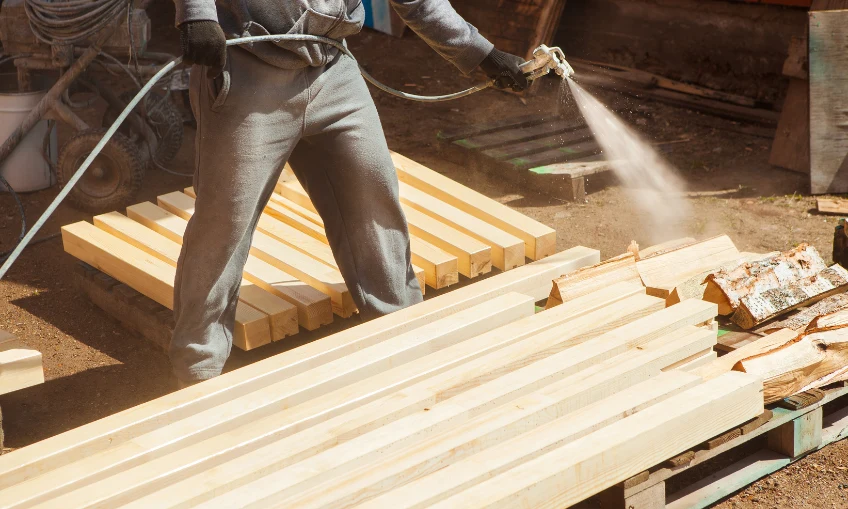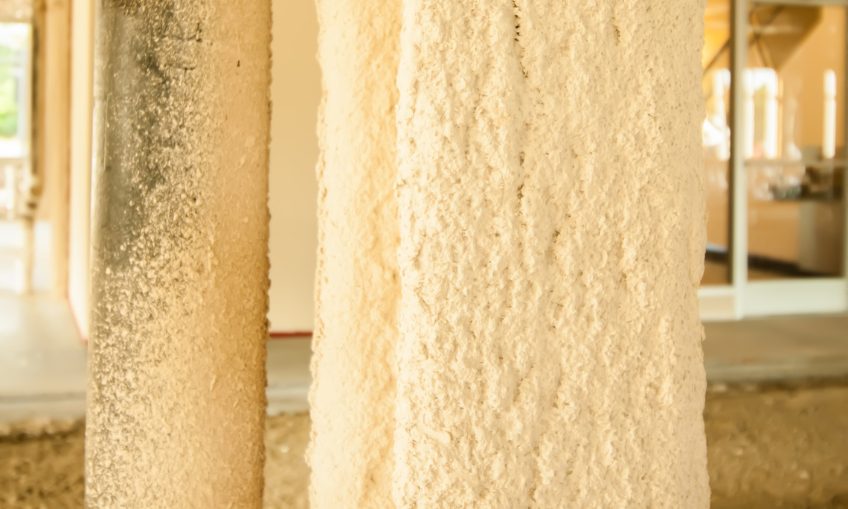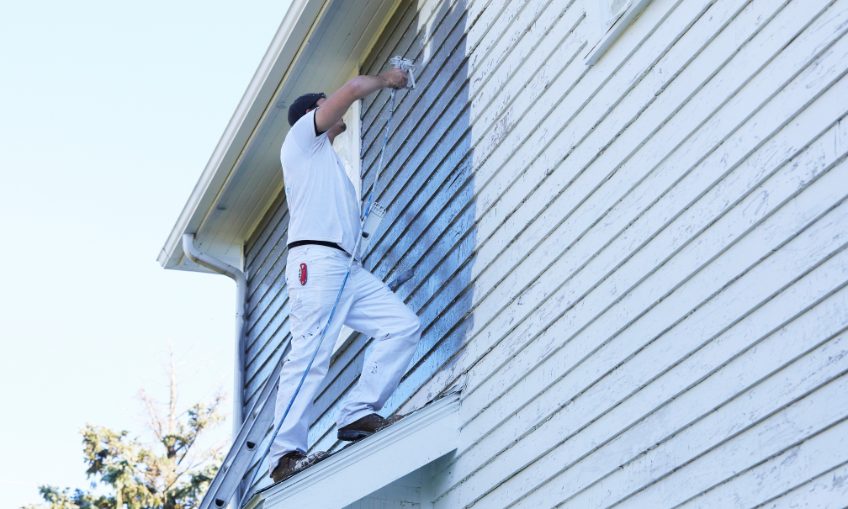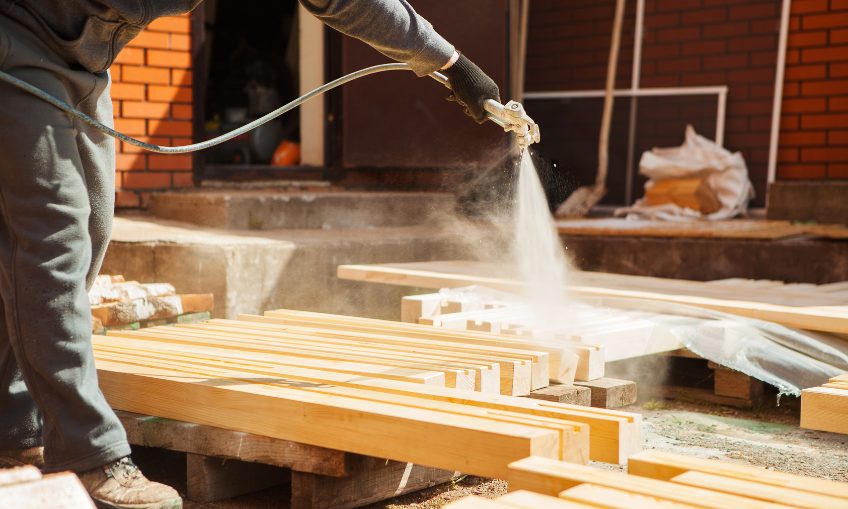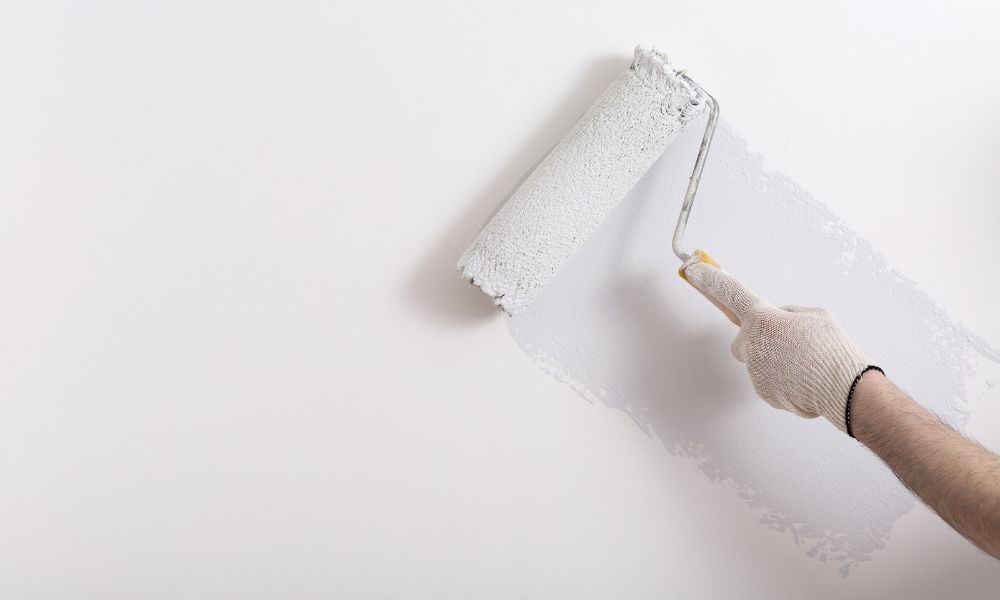Wood is a popular and versatile material used in many construction projects. It’s often used to build important parts of buildings like walls, ceilings, and floors, as well as other parts like doors, frames, and cladding. However, wood can easily catch fire and needs special protection like fire retardant coating.
These coatings work by actively slowing the spread of flames across the surface of the wood. This delay allows more time before the fire reaches the core material or substrate. In this blog, we will discuss how fire retardant coatings function, what benefits you can get, and provide step-by-step guidance on properly applying these coatings to ensure maximum safety and effectiveness.
How Does Fire Retardant Coating Work?
When subjected to high temperatures, the specialized compounds within flame retardant coatings, generally consisting of phosphorus or nitrogen, undergo a chemical reaction with oxygen and water vapor present in the environment. This reaction results in the formation of a dense, insulating foam. This foam not only acts as a physical barrier, delaying the transfer of heat and thus the spread of flames, but it also helps reduce oxygen availability near the burning surface.
By limiting oxygen, it curtails the flammability of the material it protects. This technology is particularly effective when applied to wooden materials commonly found in both commercial and residential properties. Items such as plywood panels, various types of furniture, and wooden doors can be coated with flame retardant paints to enhance their resistance to fire.
Benefits of Using Fire-Retardant Treated Wood
There are several advantages of using wood, which is treated with fire retardant coating. Some of them are listed below:
- FRTW is suitable for both interior applications, including environments with high humidity, and exterior construction projects.
- Fire retardant coating complies with different ASTM safety standards and passes through rigorous tests, including the Room Corner Test, ensuring compliance and safety in high-risk fire zones.
- In construction projects, using FRTW eliminates the need for sprinkler systems, reducing overall construction costs.
- Using fire retardant paint on wood can also save you money on insurance. Since it helps to prevent major fire damage, insurance companies might offer you a discount on your premiums. This is because the risk of costly claims is reduced.
- When ignited, fire treated wood generates significantly less smoke compared to untreated wood, enhancing safety during a fire.
- The treatment process for FRTW utilizes water-based, non-toxic chemicals, making it an environmentally responsible choice.
- These woods maintain their structural strength at higher temperatures than steel, offering reliable performance under fire conditions.
How to Apply Fire Retardant Coating on Wood?
Before you begin the application process for fire retardants, it is crucial to prepare properly by collecting the appropriate materials. When selecting a fire resistant coating, ensure it is appropriate for the type of wood you intend to treat and complies with existing safety standards and regulations.
You will also require the following essential items:
Protective Gear: Prioritizing safety is essential when working with chemicals. Equip yourself with the necessary protective gear, including safety glasses, gloves, & a mask, to protect against potential chemical exposure.
Applicator: The application method will vary depending on the chosen fire retardant product. It could be a roller, brush, or a spray gun. Select an applicator that is compatible with the texture and area of the wood surface you are treating.
Clean Cloth: Have a clean cloth readily available to address any accidental spills or to remove any excess fire retardant from the wood surface.
Ventilation: To minimize inhalation of fumes, ensure the workspace is well-ventilated. If you are working indoors, use fans or open windows to promote adequate air circulation.
Steps to Apply Fire Retardant on Wood
With all the necessary materials at hand, follow these detailed steps to apply fire retardant on wood effectively:
Step 1 – Preparation
Start by completely cleaning the wooden surface to remove all dust, dirt, or debris. A clean wooden surface will enhance the adhesion of the fire retardant. If the wood has previous treatments or paint, lightly sand it to prepare a more receptive surface for the new application.
Step 2 – Protection
Protect any nearby surfaces or areas that you do not wish to treat with fire retardant. Use plastic sheets or cloths to cover surrounding objects and maintain a clean work environment. Safety should always remain a central concern throughout this process.
Step 3 – Application
Apply the fire retardant as per the manufacturer’s instructions. Use the chosen method—be it spraying, painting, or coating—to ensure thorough and even coverage. Focus on covering joints, corners, and other areas that are particularly vulnerable to fire exposure meticulously.
Step 4 – Drying Time
Allow the applied fire retardant to dry completely. The drying period may vary based on the fire retardant type and the environmental conditions. Adhere strictly to the recommended drying time provided by the manufacturer to maximize the treatment’s effectiveness.
Is Fire Retardant Wood Considered Non Combustible?
It’s clear that wood forms a fundamental component of nearly every piece of furniture in homes and businesses. Property owners favor wood for its ability to create a warm, inviting atmosphere that adds comfort and aesthetic appeal.
However, wood’s natural composition, rich in cellulose and lignin, makes it highly flammable. Generally, fire hazards begin with a source of ignition, such as wildfires or electrical faults, which can quickly spread to nearby combustible materials, including wood.
Fortunately, using fire-retardant wood can reduce the risks and damage of fires. It’s important to note, though, that while fire-retardant wood burns more slowly than untreated wood, it is not entirely non-combustible and can still sustain some fire damage.
Conclusion
Fire retardant coating for wood enhances fire safety by slowing flame spread and reducing oxygen availability. Proper application ensures effective protection, making it a valuable safety feature for wooden structures in different properties and potentially lowering insurance costs.
Firefree Coatings provides fire retardant coatings that offer enhanced protection for wood in various applications. Our fire resistant coatings are formulated to meet the highest safety standards and provide exceptional fire resistance. With us, you can trust that your wooden structures are safeguarded against the devastating effects of fire. Call us to make an order!
Steel is one of the most common materials used in modern construction due to its strength, durability, and resistance to erosion.
However, steel can lose its strength when exposed to high temperatures during a fire. This can lead to the collapse of the building and pose significant risks to occupants and property. In this blog, we will explore the various methods and installation procedures for fireproofing a steel structure.
Importance of Fireproofing Steel Materials
Those unfamiliar with building construction might think steel is one of the most fireproof materials out there. However, while it is noncombustible, steel is not indestructible. This material reaches structural failure at 1,100 degrees Fahrenheit. As the average building fire burns at about 2,000 degrees Fahrenheit, the average fire will not necessarily melt steel—but it can weaken the material. When exposed to elevated temperatures, steel starts to deform and lose its signature strength and stability.
Fireproofing steel materials add an essential layer of protection to buildings, ensuring their structural strength in the event of a wildfire. Local building codes and regulations often mandate that structures meet specific fire safety standards. This is why implementing fireproofing strategies becomes a crucial step in helping buildings comply with these requirements and enhance their overall safety.
Government officials can halt construction projects completely if a structure does not pass fire safety inspections.
Different Methods of Steel Fireproofing
Fireproofing strategies are crucial to building design and construction, and as a result, there are many options available to ensure the safety and compliance of structures. Here are some of the common ways contractors and architects protect steel building materials:
Intumescent Paints and Coatings
The fire retardant paints and coatings are considered as the most modern and effective fire-resistant materials on the market. After a professional painter or contractor applies it to the different property assets, the paint provides passive fire protection until a fire event activates it. When the paint is exposed to flames and extreme heat, it will expand to provide a protective layer for whatever material it covers.
In the case of steel buildings, this protective layer absorbs the heat and flames that would usually cause the metal to start to melt. There are many types of intumescent paints. Some are formulated to protect certain materials, such as wood, stone, and steel. Be sure to use a fire-resistant coating made especially for the building you are designing.
Fireproof Boards
One of the more unique types of steel protection methods is using fireproof boards. These boards use fire-rated gypsum and other mineral materials to protect against flames. Like intumescent coatings, these boards prevent the spread of flames across the surface of a material. These boards have varying levels of thickness. Builders can fasten them to steel beams and other surfaces to provide protection.
Cementitious Fireproofing
Stone and mineral materials also come up in steel fireproofing. Similar to intumescent coatings, contractors can apply a cementitious material coating that also cushions steel from flames. These mixtures have various densities, which can lead to a thicker, less visually appealing coating. Cementitious mixtures are ideal for industrial applications.
Concrete has also been traditionally used for fireproofing efforts. Many contractors construct concrete columns to protect steel’s structural strength. This could involve surrounding the steel beams with a concrete shell or filling the beam with a concrete center. These natural materials provide more fire resistance and handle high temperatures better than steel.
Other Fire Safety Precautions for Steel Buildings
Alongside fireproofing materials, building designers should also put traditional fire safety technology in place in new buildings. For example, sprinklers, fire doors and windows, and other technology can help extinguish or contain a fire once it has been slowed by the materials above. The materials above are effective at preventing a fire’s spread for a certain amount of time, depending on the product.
These installations provide extra time for occupants to flee the building and authorities to arrive, but traditional fire safety technology can also help. Fire doors and windows can help contain the spread, and sprinklers can extinguish it completely. Every structure should have these modern fire safety appliances.
How to Install Fireproof Materials?
When working with fire-safe materials such as intumescent paints and coatings, it is crucial for your company to hire a reliable painter. If you do not have experienced painters on your staff, always consult a professional. Attempting to apply these paints yourself could lead to wasted resources or even put your health at risk.
Fireproof materials often utilize flame-dampening chemicals, which can pose health risks if you do not have the proper safety equipment during application. Additionally, without experience and insight into applying these materials, you could waste the coating itself or fail to apply it properly. This puts the future building and its occupants at risk because the fire safety measures may not be up to code.
Where to Find Steel Fireproofing Coatings?
If you are an architect or construction company looking for better ways to protect your steel structures, consider using intumescent paints from the fireproofing materials above. These fire-resistant paints can provide an extra layer of protection for any type of structure, including commercial buildings and industrial applications. Choose a paint that is specially designed for steel materials. You can find a variety of fire-resistant paints and coatings here at Firefree Coatings, Inc. Our experts can help you find the exact paint you need to add extra protection to your future building.
Conclusion
We hope this guide on everything you need to know about fireproofing a steel building has been informative and helpful for building owners and construction teams alike. Fireproofing any type of building material will help keep your occupants safe and protect your property from fire-related damage. If you are interested in learning more about fireproofing through intumescent paints, browse our website or contact our experts at Firefree Coatings, Inc. today. We can help match you with the safest paint for any type of application. We provide ASTM standard-testified fire retardant coatings to make your property less vulnerable to wildfire disasters.
Intumescent paint is an important component of building safety, providing passive fire protection to a structure. As building owners, officials, and contractors, it is essential to know the basics of intumescent paint and how to maintain it. In this blog, we will discuss the basics of fire retardant paint and its maintenance, as well as several steps to protect your building from fire hazards.
Basics of Intumescent Paint
The fire retardant paint is very useful in terms of protecting your property as it expands and swells in case of fire emergencies. This expansion process can increase the paint’s volume up to 50 times, shielding structural materials such as steel or wood from direct contact with heat and flames.
Intumescent coatings offer numerous benefits, including:
- Passive fire protection for up to 120 minutes
- Compatibility with many substrates
- An aesthetically pleasing finish that can easily blend with a building’s design
Applying Intumescent Paints for Longevity
Applying intumescent paint according to the manufacturer’s guidelines and the building code requirements is crucial for achieving the best results. The proper application involves thorough substrate preparation removal of debris, dust, and contaminants and priming the surface appropriately. The priming process creates an optimum bond between the intumescent paint and the substrate, which enhances the coating’s durability.
Why Do You Need Professional Painters?
When it comes to the application of intumescent paint and ensuring its effectiveness, hiring professional painters is important Professional painters are not just skilled in applying these specialized coatings; they are also well-versed in understanding and adhering to the stringent codes and regulations that govern fire safety. This attention to detail is crucial for optimizing the durability and performance of the coating, and it gives you peace of mind knowing that your project is in capable hands.
Moreover, experienced painters are familiar with the ASTM standards that fire retardant paints must meet to be considered effective. These painters offer expert consultation on selecting the most suitable intumescent paint for your specific needs. By considering factors such as the intended use or type of substrate, they can provide tailored recommendations that align with your requirements, ensuring the best possible outcome.
By entrusting your fire retardant paint needs to professionals, you can rest assured that every aspect of the process will be precise and accurate. The finished product after these paints are applied meets the highest standards of quality and safety.
Maintenance Tips for Intumescent Paint
After the successful application of intumescent paint, regular maintenance is essential for its continued efficacy. Here are some of the maintenance tips for intumescent paint after applied on certain materials:
Inspect Intumescent Coatings Regularly
Performing regular inspections ensures the continued effectiveness of your intumescent paint. These inspections include a thorough visual assessment to identify any signs of wear, damage, or degradation. Factors such as cracking, flaking, blistering, or adhesion problems may indicate a compromise in the paint’s protective capabilities.
Conducting inspections according to a schedule or after significant events, such as building renovations or nearby fires, is a proactive measure that helps to maintain the intumescent coating. By being diligent in these inspections, you can ensure that your intumescent paint provides the necessary protection for your structure.
Repair Damage or Degradation Quickly
If you detect signs of wear or damage to the intumescent coating, it is crucial to undertake necessary repairs quickly. Repairs generally involve precisely removing the affected paint, thoroughly preparing the surface by ensuring it is clean and smooth, and reapplying a fresh coat of intumescent paint.
By taking immediate action, you can effectively minimize the risk of fire damage to the structure and avoid the need for more extensive repair work in the future. Do not underestimate the significance of timely maintenance when safeguarding your property.
When To Reapply Intumescent Paint?
Reapplying intumescent paint is essential to maintaining its effectiveness. The lifespan of intumescent coatings can vary significantly depending on factors such as the quality of the initial application, environmental conditions, and exposure to moisture or chemicals.
However, a general rule of thumb is to consider reapplication every 5 to 10 years. Immediate reapplication may be necessary if an inspection reveals significant damage, wear, or degradation of the coating prior to this timeframe. Remember to consult with a professional to determine the appropriate timing for reapplication. It is always better to be proactive when safeguarding your building from potential fire hazards.
Why Intumescent Coating Maintenance Is Key?
Regular maintenance of the intumescent coating is a crucial part of ensuring its long-term performance and efficacy in fire protection. Intumescent paint, despite its durability, can degrade over time due to environmental factors, mechanical damage, or improper application. The degradation can compromise the paint’s intumescent properties, reducing its ability to swell and form a protective char layer in the event of a fire.
Regular inspections and repairs prolong the lifespan of the coating and ensure the consistent performance of the paint, ultimately maintaining the building’s structural strength and the safety of its occupants. Therefore, you should view intumescent paint maintenance not as an optional task but as a necessary part of building safety management.
Where to Find Intumescent Paint?
If you’re interested in intumescent paints for your own building or want to learn more, you can find a wide range of intumescent coatings at Firefree Coatings, Inc. We supply fire retardant paints for commercial and residential applications alike. You can find intumescent paints for a variety of common building materials such as wood, metal, and more. Contact us today for a consultation on which coating would be best for your personal applications and how to get started. If you are looking for a way to protect your building for years to come, consider fire retardant paint from Firefree Coatings, Inc.
Conclusion
Intumescent paints play a crucial role in protecting buildings from fire hazards. Understanding the basics of this specialized coating, following proper application procedures, and hiring professionals for both application and maintenance are key to ensuring its longevity and effectiveness. Regular inspections and timely repairs are crucial to maintain the strength of intumescent paint and ensure utmost building safety. By following these guidelines and this beginner’s guide to maintaining intumescent paint, you can ensure your building is well-protected and compliant with fire safety regulations for years to come.
Wildfires have always been a part of the natural cycle in many ecosystems. These fires not only destroy vast areas of land and property but also pose significant threats to human life, wildlife, and the environment. While natural factors like lightning strikes and dry conditions have always played a role in igniting wildfires, all of us have seen a significant increase in their frequency and intensity in recent years. In this blog, we will highlight the relationship between substantial climate changes and wildfires. We will also discuss how pfp (passive fire protection) coating on different materials can save you and your property during wildfires.
The Connection Between Climate Change and Wildfires
Climate change affects the likelihood, intensity, and spread of wildfires in several ways. First, rising global temperatures lead to drier vegetation, creating more fuel for flames and increasing the risk of wildfires. Moreover, higher temperatures can cause more frequent and prolonged droughts, further contributing to vegetation dryness and flammability.
Second, climate change can alter precipitation patterns. This can lead to extended dry periods in certain regions, exacerbating the conditions favorable to wildfire ignition and spread. In other areas, more intense rainfall events may provide short-term relief, but they may not be enough to counteract heat waves and long-term droughts. Additionally, stronger winds can also exacerbate fire spread and intensity by providing more oxygen, which increases the combustibility of the fuel, stokes embers, and allows fires to jump over firebreaks.
How Have Wildfires Changed Due to Climate Change?
According to the Environmental Protection Agency, climate change has affected several wildfire qualities, including the frequency of wildfires and the duration of wildfire seasons. Many ecosystems rely on a seasonal fire regimen, with wildfires generally occurring during specific periods throughout the year. However, with shifting precipitation and temperature patterns due to climate change, the fire seasons might become longer, allowing wildfires to occur outside the usual seasonal windows and potentially disrupting ecosystems.
Mitigation Strategies for Climate-Caused Wildfires
Addressing the relationship between climate change and wildfires requires a comprehensive, and attentive approach. Some strategies to mitigate the negative effects of climate-caused wildfires include:
- Utilizing controlled burns to reduce fuel loads. This thins forests to create space between trees and creates fuel breaks, preventing wildfires from becoming unmanageable. Well-maintained forest ecosystems with a healthy balance of vegetation are more resilient to wildfires.
- Urban planning to evaluate fire-prone areas and establish fire-safe zones. Architects and engineers can design and build structures with fire-resistant materials and firewise designs to protect homes and buildings from fire spread. PFP, or passive fire protection, coatings are one example of materials that builders can use to reinforce homes and commercial buildings.
- Investing in advanced fire detection and monitoring systems. This can ensure rapid response to wildfires, detecting them before they escalate. Developing comprehensive emergency plans and educating the public about wildfire risks and preparedness measures are also crucial.
Conclusion
The relationship between climate change and wildfires is undeniable. Taking proactive measures to address climate change and implementing comprehensive strategies to prevent and mitigate wildfires can protect communities, ecosystems, and economies from the devastating effects of these events. Individuals, businesses, and governments must work together toward a sustainable future in the face of a changing climate. You can learn more about the steps you can take during the building process to minimize fires with our selection of passive fire protection coatings at Firefree Coatings, Inc. We provide ASTM-tested fire-resistant coatings that can be applied to various materials and make your home more fireproof during wildfires.
The construction industry is continuously evolving, and builders, architects, and building officials must keep up with the latest trends and advancements in materials. One such development is the use of fire-retardant treated wood (FRTW). Industry professionals can make informed decisions on how to maximize the safety and longevity of their projects using fire-retardant treated wood.
Flame retardant coatings are applied to lumber or plywood and make them less combustible, providing an added layer of protection for the buildings and structures they support. In this blog, we will discuss the benefits of using fire-retardant treated wood.
Enhances Safety for Buildings and Structures
One of the most significant advantages of using fire-retardant treated wood is its increased safety. When exposed to fire, untreated wood will burn quickly, allowing flames to spread throughout the structure and causing irreparable damage. FRTW, on the other hand, slows the spread of flames and reduces smoke production. This added layer of protection is important because it can provide occupants with valuable time to evacuate the premises and allow firefighters more time to extinguish the flames, potentially saving lives and property.
FRTW also protects the structural components of a building. When exposed to high temperatures, untreated wood can weaken, leading to structural collapse. The chemical treatment of FRTW helps maintain its structural strength under extreme heat, reducing the likelihood of a complete structural failure.
Ensures Compliance With Building Codes
In recent years, building codes have become more stringent regarding fire safety measures. Many jurisdictions now require fire-retardant treated wood in specific applications, such as in multifamily residential buildings, commercial structures, and schools. By utilizing FRTW, everyone involved in the building planning process can demonstrate compliance with these codes, reducing the risk of fines, penalties, and potential legal ramifications.
Promotes Additional Longevity and Durability
Aside from enhanced fire safety, fire-retardant treated wood also offers additional benefits in terms of longevity and durability. The chemical treatment process helps protect against wood decay, fungi, and insect damage, resulting in a more robust and long-lasting product. This increased durability translates to lower maintenance costs over the building’s life and a longer lifespan for the structure.
Conclusion
If you are a builder, an architect, or a building official, fire-retardant treated wood can significantly contribute to our projects’ success and longevity. FRTW should be a strong consideration in the planning and design of any construction project where the safety and protection of building occupants and property are at stake.
If you are looking for additional ways to offer fireproofing for your building projects, Firefree’s Class A flame retardant coatings provide fire-treated wood protection with only one coat. Contact us today to learn more about our fireproofing coatings and how you can use them to achieve fire-retardant treated wood to protect structures and comply with fire safety regulations.
Fire-resistant paint is a crucial safety feature for any residential or commercial building. However, before making a purchase, there are several factors you should know to ensure you achieve the maximum protection and best results. Keep reading to explore these important things to consider when choosing a fire-resistant paint for your residential or commercial building project.
(more…)Wildfires threaten the environment and damage ecosystems, property, and life. As climate change exacerbates the frequency and intensity of these events, everyone should know some wildfire prevention strategies. Then, we can mitigate the occurrence and damage of wildfires.
(more…)As a building owner, one of your highest priorities should be the safety of your occupants. One way to ensure that safety is by conducting regular fire risk assessments. Keep reading to explore the things to ask during fire risk assessments to promote a productive assessment process. From what a fire risk assessment is and why it is crucial for any building to identifying hazards, you will learn everything you need to know about completing a successful assessment.
(more…)Intumescent coatings are crucial components in fire protection systems for various industries like construction, engineering, and architecture. They are passive fire protection products designed to expand and create a protective layer when exposed to high temperatures. The primary objective of intumescent coatings is to protect structural components from fire damage. To get a better understanding of these coatings and how they can benefit your structures and applications, consider the life span of intumescent coatings and the factors that impact their durability.
(more…)Contact: Elisa Vivas
FOR IMMEDIATE RELEASE
FIREFREE 88 RECEIVES PRODUCT APPROVAL
NOVATO, CA, November 1, 2023 – Firefree 88, First FM Approved Coating to Improve Wood Roof Deck Assembly from Class 2 to Class 1.
Recently, FM Approvals www.fmapprovals.com tested and certified Firefree 88, water based latex intumescent coating manufactured by Firefree Coatings Inc, as the first and only intumescent coating to pass the FM 4470 (NFPA 276) Roof Assemblies for Use in Class 1 and Non Combustible Roof Deck Construction Assemblies.
Prior to this, all FM Approved Coatings were limited to steel roof decks.
Firefree 88 first approval was in 2004, when it was tested in accordance to FM 4975 and part 1 of FM 4880. Firefree 88 is an intumescent coating that can be applied to a variety of materials that prevents flame spread and reduces smoke developed generation to the coated substrates. Tests results have shown that Firefree 88 is able to withstand temperatures up to 2200 degrees Fahrenheit.
Firefree 88 is non-toxic, eco-friendly and applies as easily as paint. Because of its ease of application and minimal inconvenience to occupants, Firefree 88 is a very cost-effective and time savings solution versus solutions that may increase the load on a structure, often resulting in a conservative 50% to 70% savings (traditional methods can also add extensive disruption to occupants).
Firefree 88 can be applied over most existing latex paint or it can be top coated with latex paint, which will not impact the performance of the coating.
About The Manufacturer
Firefree Coatings, Inc, Inc., a California based corporation, was established in 1994. The company identified the need for an improved, durable, inexpensive, non-toxic fire protection coating; As a result, Firefree 88 was first launched in 2000. Based on the success of Firefree 88 first full scale test per ASTM E119, the coating was accepted by various safety and building code regulators allowing the use in residential, commercial, industrial, and other sectors of the construction industry. The company has performed and continues to conduct extensive fire tests to meet the increasing demand for fire safety utilizing the standards established by the American Society of Testing Materials (ASTM). Firefree Coatings, Inc, Inc., has built a strong network of representatives and distributors throughout the US and abroad.
For more information, please contact Firefree Coatings, Inc by email info@firefree.com – toll free at 888-990-3388 (US & Canada), 415-459-6488 (international), or visit www.firefree.com.
